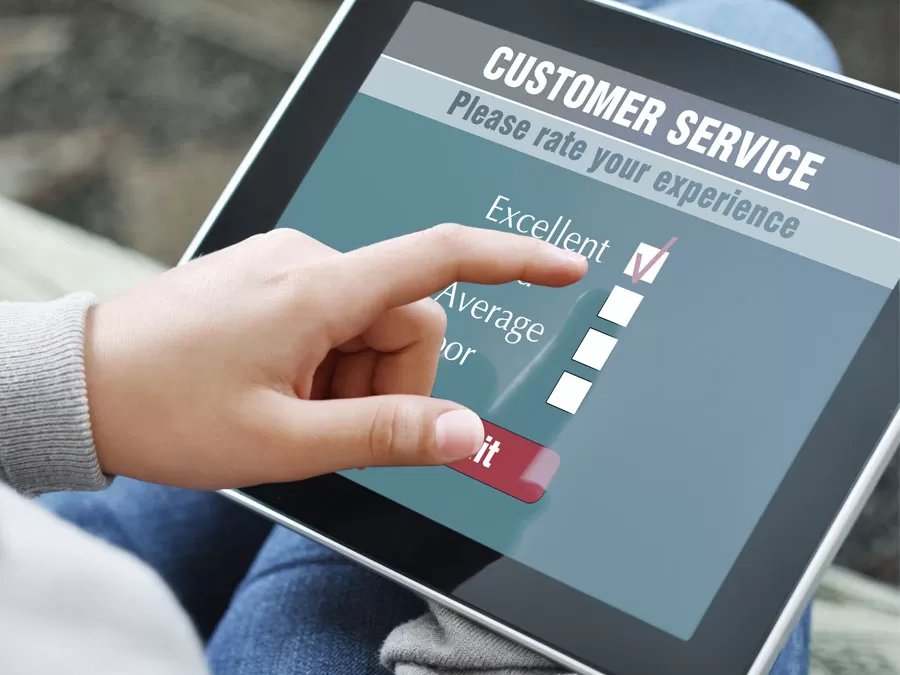Once you’ve finally gathered customer service feedback by integrating phone surveys in your call center support services or by asking customers to fill out forms, the next step is to process the results and act on them.
As a business owner, you understand the importance of gaining insights and feedback from your customers. Customer surveys are a powerful tool that allows you to collect valuable data and understand the needs and preferences of your target audience.
However, the true value lies not just in collecting the data but also in taking action based on the results. Of course, it’s not going to be an easy task. Customer satisfaction analysis is a crucial aspect of customer service that any form of misguided handling of feedback can lead to wrong corporate decisions.
But there are some tricks that you can do to effectively put survey results into use by integrating them into your organizational practices.
By following these steps, you can harness the power of customer feedback to improve your business, enhance customer experience, and drive growth:
-
Analyzing Survey Results:
Unleashing the Power of Data InsightsAfter collecting a significant number of customer survey responses, it’s time to dive into the data and analyze the results. The analysis of survey results is crucial for extracting meaningful insights that can guide your decision-making.
To effectively analyze the data, utilize data visualization tools that can help you interpret the information quickly and efficiently. Look for keywords, patterns, and customer preferences that emerge from the responses. By analyzing survey results, you gain a deeper understanding of your customers’ needs, expectations, and pain points.
Identifying trends and patterns in the survey data can provide valuable insights into customer behavior and preferences. Look for common themes or recurring feedback that can shed light on areas where your business excels and areas that need improvement.
By identifying these patterns, you can make data-driven decisions that align with your customers’ preferences and expectations.
Furthermore, data analysis can help you identify specific customer segments or demographics that have unique needs or preferences. This information allows you to tailor your marketing strategies and product offerings to better serve those segments.
For example, if your survey results show that a particular age group prefers a specific feature or communication channel, you can prioritize that in your marketing efforts to better resonate with that audience.
-
Identifying Actionable Insights:
Turning Data into ActionAnalyzing survey results is just the first step; the real value comes from identifying actionable insights. Categorize the survey responses into themes and topics to make sense of the data. By doing so, you can identify common issues and areas for improvement that require your attention.
Pay close attention to recurring complaints or concerns voiced by your customers. These insights can serve as a roadmap for addressing pain points and enhancing the overall customer experience.
Prioritize actionable insights based on their impact and feasibility. Determine which issues have the most significant potential to improve customer satisfaction and loyalty while considering the resources and capabilities of your business.
For instance, if your survey results reveal that customers are dissatisfied with the response time of your customer support team, you can prioritize implementing strategies to improve the efficiency and effectiveness of your support system.
This could involve investing in training programs for your support staff, implementing new customer service technologies, or refining your internal processes to streamline the resolution of customer inquiries.
By identifying actionable insights, you can focus your efforts on the areas that will have the most significant impact on customer satisfaction and overall business success.
-
Addressing Issues and Improving Customer Experience:
Taking Concrete StepsNow that you’ve identified the areas that need improvement, it’s time to develop an action plan to address these issues and enhance the customer experience. Your action plan should outline the specific steps you will take to implement changes based on the insights derived from the survey results.
Begin by setting clear objectives and goals for each area of improvement. Define measurable metrics to track progress and ensure that your actions align with the feedback and expectations expressed by your customers. This will enable you to track the effectiveness of your efforts and make data-driven adjustments as necessary.
Implementing changes to improve the customer experience may involve various aspects of your business operations. It could mean refining your product or service offerings, enhancing the usability of your website or app, or streamlining communication channels to ensure prompt and effective customer support.
In such cases, you should collaborate with relevant teams and departments within your organization to ensure a coordinated effort in implementing these changes.
For example, if your survey results indicate that customers find it difficult to navigate your website, you can invest in user experience (UX) design improvements. Conduct usability tests, gather feedback from customers, and work closely with your web development team to create a more intuitive and user-friendly website interface.
Remember, addressing issues and improving the customer experience is an ongoing process. Continuously monitor customer feedback, track progress, and refine your strategies based on the insights you gather along the way.
By taking concrete steps to address issues, you demonstrate your commitment to providing exceptional customer service and fostering customer loyalty.
-
Communicating Findings and Action Plan:
Keeping Stakeholders InformedEffective communication is crucial when it comes to sharing survey findings and your action plan with relevant stakeholders. Stakeholders can include your team members, departments involved in the improvement process, and even your customers themselves.
Also, transparency in communication builds trust and ensures that everyone is on the same page regarding the survey results and the actions you plan to take.
Share the insights and outcomes of the survey with your team and explain how their efforts contributed to the overall feedback. This fosters a sense of ownership and motivates your team to actively participate in the improvement process.
In addition to internal communication, consider sharing the highlights of the survey results with your customers. While you may not be able to address every individual concern, showing that you value their feedback and are taking steps to improve can enhance their trust and loyalty.
Utilize various communication channels to disseminate the information effectively. This can include reports, presentations, team meetings, or even internal newsletters. Encourage open dialogue and invite feedback and suggestions from stakeholders.
By involving your team and customers in the process, you create a collaborative environment focused on continuous improvement.
By effectively communicating survey findings and the action plan, you create a sense of transparency, accountability, and unity within your organization, leading to a more customer-centric approach.
Monitoring and Measuring Progress: Keeping Track of Success
To ensure the effectiveness of your actions, it’s essential to monitor and measure progress. Establish key performance indicators (KPIs) that align with your goals and objectives. These KPIs should be measurable and provide insights into the impact of the changes implemented based on customer survey feedback.
Regularly monitor and analyze data to evaluate the success of your initiatives. Leverage analytics tools and feedback mechanisms to gather ongoing insights and identify areas that require further attention or adjustment. This allows you to make data-driven decisions and refine your strategies to further enhance the customer experience.
For example, if one of your goals is to improve customer satisfaction, you can track metrics such as Net Promoter Score (NPS), customer retention rate, or customer support ticket resolution time. By consistently monitoring these metrics, you can assess the effectiveness of your actions and identify opportunities for improvement.
Additionally, gather feedback from your customers on an ongoing basis. This can be done through follow-up surveys, customer feedback forms, or social media engagement. Actively listen to your customers’ voices and use their input to make data-driven decisions that meet their evolving needs.
Remember that monitoring progress is not a one-time task but an ongoing effort. Regularly evaluate your performance against the established KPIs, make adjustments as necessary, and celebrate milestones achieved along the way.
Engaging with Customers: Cultivating Relationships and Loyalty
Customer engagement is a crucial aspect of post-survey actions. Actively engaging with your customers helps cultivate strong relationships and fosters loyalty. It demonstrates your commitment to meeting their needs and continuously improving their experience.
Share updates with your customers on the changes you’ve made based on their feedback. This can be done through newsletters, social media posts, or personalized emails. Show gratitude for their participation in the survey and emphasize the value you place on their input.
Additionally, consider incorporating customer feedback mechanisms into your ongoing operations. This can include customer feedback forms, live chat support, or customer advisory panels. By giving customers a platform to voice their opinions and suggestions, you create a sense of inclusivity and show that their feedback is valued.
Engaging with customers also provides an opportunity to gather additional insights and understand their evolving needs. Regularly seek their feedback through follow-up surveys or personalized interactions.
This not only strengthens your relationship with existing customers but also helps you attract new customers by demonstrating your commitment to customer satisfaction.
Outsourcing Customer Support: Making the Most Out of Your Findings
Outsourcing customer support is a strategic decision that can significantly enhance the value and impact of the customer survey results you’ve gathered. By entrusting your customer support function to a specialized external provider, you can leverage their expertise, resources, and technology to maximize the benefits derived from the survey data.
Let’s explore how outsourcing customer support can help you make the most out of your customer survey results.
-
Scalability and Flexibility
One of the key advantages of outsourcing customer support is the ability to scale your operations based on the volume of survey responses and customer inquiries. During peak periods, such as after conducting a large-scale survey, you may experience a surge in customer inquiries and support demands.
Outsourcing enables you to access a team of trained professionals who can handle high call volumes, respond to emails promptly, and provide live chat support effectively. This scalability ensures that you can meet customer needs in a timely manner, improving their satisfaction and maintaining a positive brand image.
Outsourcing also offers flexibility in adjusting the level of support based on your business needs. If you anticipate a decrease in customer inquiries following the survey, you can easily reduce the outsourced support resources to align with the reduced workload.
This flexibility allows you to optimize your customer support costs while still ensuring a high level of service during critical periods.
-
Expertise and Specialization
Outsourcing customer support means partnering with a provider that specializes in delivering exceptional customer service.
These providers have extensive experience in handling various customer issues, including those identified in your survey results. Their expertise enables them to address customer inquiries effectively, provide accurate information, and offer appropriate solutions.
By leveraging the knowledge and skills of the outsourced customer support team, you can ensure that every customer interaction is handled professionally and with the utmost care.
Their expertise extends beyond basic support to encompass understanding customer sentiments, managing customer expectations, and even identifying opportunities for upselling or cross-selling. This level of specialization enhances the overall customer experience and contributes to increased customer satisfaction and loyalty.
-
Multichannel Support
Customer surveys often reveal the preferences of customers regarding communication channels. Outsourcing customer support enables you to provide multichannel support options that align with the preferences expressed by your customers in the survey.
Whether it’s phone support, email responses, live chat, or social media interactions, outsourcing partners can adapt to the specific channels your customers prefer, ensuring a seamless and consistent experience across all touchpoints.
Moreover, outsourcing providers typically have advanced technology and tools to efficiently manage multichannel interactions. They can implement customer relationship management (CRM) systems, ticketing systems, and chatbot integrations to streamline communication and ensure prompt and accurate responses.
This technology-driven approach enables efficient handling of customer inquiries, minimizes response times, and improves the overall customer experience.
-
Data Analysis and Insights
Outsourcing customer support can offer valuable data analysis capabilities that complement your survey results. The outsourced provider can gather and analyze customer interactions, feedback, and inquiries to extract actionable insights. These insights can be used to further refine your products, services, and overall customer experience.
Through sophisticated analytics tools and methodologies, outsourcing partners can identify emerging trends, common customer concerns, and areas for improvement. This data-driven approach allows you to align your business strategies with the feedback received from customers, driving continuous improvement and enhancing customer satisfaction.
Additionally, outsourcing providers can generate comprehensive reports and dashboards that provide a holistic view of customer support performance. These reports can include metrics such as response times, customer satisfaction scores, and resolution rates.
By reviewing these reports, you can gain a deeper understanding of how customers perceive your support efforts and identify opportunities for further optimization.
Outsourcing customer support can be a game-changer when it comes to making the most out of your customer survey results. By leveraging the scalability, expertise, multichannel support, and data analysis capabilities offered by outsourcing partners, you can effectively address customer needs, improve satisfaction levels, and drive long-term business success.
The insights gained from the survey, combined with the capabilities of the outsourced customer support team, create a powerful synergy that enables you to enhance the overall customer experience and build strong, lasting relationships with your customers.
Collecting customer survey results is just the beginning. To truly benefit from customer feedback, it’s essential to take action. Analyze the results, identify actionable insights, address issues, communicate findings, monitor progress, engage with customers, and celebrate successes.
By following these four essential steps, you can leverage the power of customer survey data to improve your business, enhance the customer experience, and drive long-term success.
Remember, the insights you gain from your customers are invaluable—they provide a roadmap for growth and help you build strong, lasting relationships with your target audience. Embrace the feedback and let it guide you on the path to business excellence.
Boost customer experience and elevate consumer retention when you partner with an experienced outsourcing provider. Open Access BPO has multilingual customer care in over 30 languages, manned by expert teams from our seven global locations. Contact us today so we can start creating a personalized business plan for your brand.











